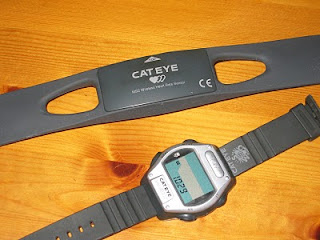 Okay well maybe 20 years ago is a bit reaching, but since I have had this Cateye Heartrate Monitor (and bike computer) fro well over 5 years now it does make sense that I might actually have used it.
Okay well maybe 20 years ago is a bit reaching, but since I have had this Cateye Heartrate Monitor (and bike computer) fro well over 5 years now it does make sense that I might actually have used it.Last week I had my LT measured (lactic threshold). Now I haven't posted about that yet as I am waiting for my full report to come back to me. But during this event I wore my good old heartrate monitor. I wasn't even sure if it would work. It has been a long time since I wore it. And even then, I wore it more as a source of amusement than anything else. I really had no idea what I was supposed to do with the information it was telling me, but it was nice to know my heart was working.
Anyway, I know everyone has fancy Garmin's and GPS pace thingies and power meters etc... but alas I do not. For running I have used my circa 2000 Ironman brand Timex watch to keep track of things and a little math in my head. I guess that hasn't been too bad for me, but of course all that info told me was how fast I was running overall, not how hard I was working.
Now that I have decided to actually train for gain this year, I figured knowing a bit about how I ticked was a good thing. The LT test was a start (enough already I will write about that later). So yesterday, for the first time ever, I wore my good old Cateye for a run. Well actually it was a bit of a brick workout as the pavement was so nice and dry I had to get a little 10K bike ride in first to warm me up.
Starting out already nice and warm on the run meant my heart rate quickly climbed to around 140 bpm after the first kilometer or so. I figured this was a good point to keep it at for the duration of my training session. This number is well below my LT and maybe even considered to be in some sort of zone (I haven't got all that figure out yet). So I should be able to keep a rather nice even training pace at this heartrate.
My regular winter run is a sidewalk run of 10K which is slightly rolling in terrain, though no real "hills" to speak of. Armed with my new wrist toy I found myself looking down at my bpm number quite often. 137, 142, 139, 140, 143, etc... It seemed to be staying rather steady as I plodded along. I felt good as my pace didn't seem to alter much (I still use head math for pace calculations). Then close to home on the way back as I approached the real hill of the run I checked out my numbers at teh bottom of the hill, 142 bpm. Then halfway up, 149 bpm. Then at the top 157 bpm. Then cresting the top, 153 bpm. Wow. I didn't expect that much change. My pace stayed the same and my body worked harder. Who woulda thunk it? Again hitting my subdivision, 140 at the entrance, 164 at the top of the hill, 150 as I crested the top and started down the other side.
What do I do with this information? Well, I suppose I take it and devise some sort of training plan based on all these zones I read about. Hopefully this will help me avoid running to hard in sections of my base period training runs, which will help me recover faster and lead to me heading out for more runs. My usual sprints up the hill at this time of year and during longer runs might not be a good idea as I see it actually means my system needs to work a little more.
I guess I will see how well this style of training helps me to improve. Maybe I am 20 years late to the training table, maybe this system is passé? We'll see I guess.

No comments:
Post a Comment